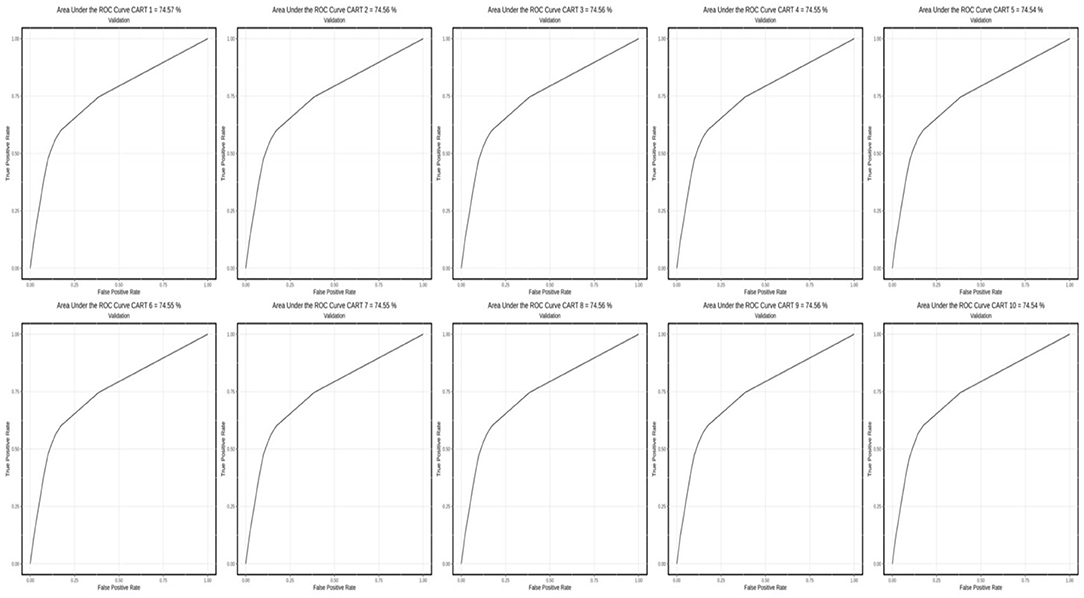- 1Department of Statistics, Faculty of Mathematics and Natural Science, Hasanuddin University, Makassar, Indonesia
- 2Department of Epidemiology, Faculty of Public Health, Hasanuddin University, Makassar, Indonesia
- 3Department of Mathematics, Faculty of Mathematics and Natural Sciences, Hasanuddin University, Makassar, Indonesia
- 4Department of Health Promotion, Faculty of Public Health, Hasanuddin University, Makassar, Indonesia
Obesity is strongly associated with multiple risk factors. It is significantly contributing to an increased risk of chronic disease morbidity and mortality worldwide. There are various challenges to better understand the association between risk factors and the occurrence of obesity. The traditional regression approach limits analysis to a small number of predictors and imposes assumptions of independence and linearity. Machine Learning (ML) methods are an alternative that provide information with a unique approach to the application stage of data analysis on obesity. This study aims to assess the ability of ML methods, namely Logistic Regression, Classification and Regression Trees (CART), and Naïve Bayes to identify the presence of obesity using publicly available health data, using a novel approach with sophisticated ML methods to predict obesity as an attempt to go beyond traditional prediction models, and to compare the performance of three different methods. Meanwhile, the main objective of this study is to establish a set of risk factors for obesity in adults among the available study variables. Furthermore, we address data imbalance using Synthetic Minority Oversampling Technique (SMOTE) to predict obesity status based on risk factors available in the dataset. This study indicates that the Logistic Regression method shows the highest performance. Nevertheless, kappa coefficients show only moderate concordance between predicted and measured obesity. Location, marital status, age groups, education, sweet drinks, fatty/oily foods, grilled foods, preserved foods, seasoning powders, soft/carbonated drinks, alcoholic drinks, mental emotional disorders, diagnosed hypertension, physical activity, smoking, and fruit and vegetables consumptions are significant in predicting obesity status in adults. Identifying these risk factors could inform health authorities in designing or modifying existing policies for better controlling chronic diseases especially in relation to risk factors associated with obesity. Moreover, applying ML methods on publicly available health data, such as Indonesian Basic Health Research (RISKESDAS) is a promising strategy to fill the gap for a more robust understanding of the associations of multiple risk factors in predicting health outcomes.
Introduction
Obesity is a major health problem strongly associated with many chronic illnesses with negative effects and long-term consequences, not only for the patients but also their families. In Southeast Asia, problems related to nutrition or malnutrition are a double burden because the number of cases of malnutrition and malnourishment is still relatively high and the number of cases of obesity has also increased significantly over time (1).
Data from the 2013 national-level survey of Indonesian Basic Health Research (RISKESDAS) showed the prevalence of obesity in Indonesia has increased over the years. Obesity among adult men was 13.9% in 2007, 7.8% in 2010, and 19.7% in 2013, whereas for adult women the prevalence was 14.8% in 2007, 15.5% in 2010, and increased drastically to 32.9% in 2013 (2). By 2018, the same survey (RISKESDAS 2018) showed that the prevalence of obesity in men and women had decreased slightly to 14.5 and 29.3%, respectively (3).
Risk factors for obesity have been studied extensively, and in general, they are divided into several categories: demographic and socio-economic factors (gender, age, education, income, marital status, and urban areas) (4–6); lifestyle factors (consumption of fast food, stress, smoking, alcoholic drinks, and low level of physical activity) (6, 7); and genetic factors (obese parents) (4, 5). Among these risk factors, some can be changed or modified, while others cannot. Identifying modifiable risk factors for obesity at the individual and the population level is urgently required in order to implement an effective risk reduction strategy. Numerous studies have explored better approaches to predicting obesity using available data. A novel method recently introduced to answer this question uses Machine Learning (ML), which is currently one of the most popular topics in the scientific community for large-scale datasets.
Epidemiological data modeling using ML approaches is becoming increasingly popular in the published scientific literature. These methods have the potential to improve our understanding of general health regarding disease distribution, detection, and the identification of risk factors for health problems, and thus, opportunities for intervention. Various ML methods and algorithms have been applied to various aspects of health data including obesity (8). In the case of obesity, it is essential to develop a precise data classification to facilitate the process of finding predictive risk factors from the given data, in efforts to control these risk factors and eventually to decrease morbidity and mortality linked to obesity.
For the purpose of obesity prevention, ML has been used to predict the probability of obesity based on data encoding adherence to dietary recommendations and several other factors (9). The ML has also been applied for the prediction of obesity in children using electronic health records before the age of 2 (10); prediction of obesogenic environments for children (11); and for the aggregation of metabolomics, lipidomics, and other clinical data to modeling drug dose responses (12).
Based on previous research, ML approaches can increase the risk prediction of health outcomes compared to conventional approaches (13). Prediction of obesity using ML has been investigated by many researchers: Zhang et al. (14), Adnan et al. (15), Toschke et al. (16), Golino et al. (17), Dugan et al. (10), Zheng and Ruggiero (18), Chatterjee et al. (19), Singh and Tawfik (20), and Colmenarejo (21). The ML approach provides an alternative in providing information with a unique approach at the application stage of data analysis on obesity which is important in providing a better predictive solution to the likelihood of obesity (22).
Materials and Methods
Data Source
The dataset used to develop the classification model in this study is publicly available data from an Indonesia national scale survey with a cross-sectional and non-intervention design, the RISKESDAS survey, which was conducted by the Indonesian Ministry of Health. The RISKESDAS report is a community-based health survey whose indicators can be generalized with variables described from the national level down to the district/city level. It is conducted every 5 years across 34 provinces and 514 districts/cities in order to track important indicators of public health status, diseases risk factors, and to evaluate healthcare services delivery programs. The methodology and detailed protocols of the survey are described elsewhere (3). Briefly, the target sample for this study is 300,000 households from 30,000 Census Block (CBs) in 34 provinces and 514 district-cities throughout Indonesia. The sampling frame lists are provided by the Central Bureau of Statistics (BPS) using a two-stage sampling method. In the first stage, 180,000 CBs (25%) were selected from 720,000 CBs from the national socio-economic survey (SUSENAS) as a sampling frame using a proportionate to population size (PPS) method and stratified by prosperity level, continued by systematically selecting 30,000 CBs from 180,000 CBs priorly selected and stratified by urban and rural for each district or city. In the second stage, 10 households were selected systematically using implicit stratification for the education level of the head of household to maintain variation of education among households. Household members who were eligible according to the inclusion criteria were invited to participate in the interview.
The dataset can be accessed by request at the Institute of Health Research and Development of the Indonesian Ministry of Health (https://www.litbang.kemkes.go.id/layanan-permintaan-data-riset/).
Pre-processing Data
Data Cleaning or Filtering
The sample used in this study included all the data from the RISKESDAS dataset for individuals aged 18 or above; in total there was data for 634,709 respondents. We conducted data cleaning by excluding all records with incomplete or missing values for the variable/feature Body Mass Index (BMI), a core feature used to categorize obesity status. The number of samples included for the analysis process after cleaning was 618,898 records. Data cleaning was performed by using the dplyr package of R version 3.5.1 to perform filtering (23).
Feature Selection
After removing missing values, we proceeded to variable or feature selection. Variable selection is a process of reducing the data dimensions to reduce processing time as well as computation costs (24). We selected a subset of variables that contributed significantly to the target class to improve the overall predictive performance of the classification using the Chi-Square (χ2) test between obesity status with each of the variables and including those with a p-value <0.05. All features that met these criteria (a total of 21 features) were selected for developing the classification model. These variables or features were location (X1), marital status (X2), age group (X3), education (X4), work category (X5), sugary foods (X6), sweet drinks (X7), salty foods (X8), fatty/oily foods (X9), grilled foods (X10), preserved foods (X11), seasoning powders (X12), soft/carbonated drinks (X13), energy drinks (X14), instant foods (X15), alcoholic drinks (X16), mental-emotional disorders (X17), diagnosed hypertension (X18), physical activity (X19), smoking (X20), and fruit and vegetables consumptions (X21). A list of these features and how it was generated from the questionnaire (for composited and calculated feature, i.e., obesity, fruit and vegetables consumption, physical activity, and mental-emotional disorders) can be found in the Supplementary Table 1. The process of developing a classification model was carried out by using the R Statistical Software version 3.5.1 (25).
Dealing With Imbalanced Datasets
Data imbalance occurs when there are one or more classes that dominate the whole data as major classes, and other classes are rare occurrences or minor classes. Imbalanced data will produce a good classification prediction accuracy against the major class, but in the minor class, the resulting accuracy is poor.
The Synthetic Minority Oversampling Technique (SMOTE) was introduced by Chawla et al. (26) and Chawla (27), as a way of dealing with the effect of the lack of information on minority classes in a data set. SMOTE is an algorithm with an oversampling approach, which generates artificial data for minority data classes (28) so that the proportions of major and minor data classes are more balanced (29). Artificial data or synthetic data are made based on the k-nearest neighbor. All attributes used in this study were categorical features so that the calculation of the distance between the minor class samples was carried out using the Modify Value Difference Metric (MVDM) method (30). In this method, several steps are taken, namely calculating the distance between two observations at a nominal scale and choosing the majority category between the minority class observations with its k-closest neighbors for a nominal value, and if the same value occurs, it is chosen randomly. Furthermore, the selected value is a new observation. In this study, the SMOTE technique with oversampling of 200% and 300% was used which resulted in two new datasets.
Machine Learning Classification Methods
Logistic Regression
One of the basic linear models developed with a probabilistic approach to classification problems is Logistic Regression (31) and is one of the supervised learning models widely used in ML. Logistic Regression can be seen as a development of Linear Regression models with a logistic function for data with a target in the form of classes (32) as follows:
where is the D-dimensional data, are the weight parameters, β0 is the bias parameter, and σ is a logistic function that is shaped as .
The weights of β can be obtained by using probabilistic concepts. For example, if yn = y(xn) and tn ∈ {0, 1} are an independent identical distribution. The joint probabilistic or likelihood function for all the data can be expressed by the Bernoulli distribution p(t|β), where . Therefore, the Logistic Regression learning and bias (β) is to maximize p(t∨β). The learning method for determining the weight and bias (β) parameters is known as the maximum likelihood method. Generally, the solution to the maximum likelihood problem is done by minimizing the negative of the logarithm of the likelihood function, namely , where E(β) = −ln(p(t∨β)). Logistic Regression models can use regularization techniques to solve the problem of overfitting by adding the weight norm ||w|| in the error function, namely , where C > 0 is the inverse parameter of the regulation.
Simultaneous and partial parameter testing is performed to examine the role of predictor variables in the model. Simultaneous parameter testing uses the G test.
Classification and Regression Trees
Breiman et al. (33) proposes a new algorithm for tree arrangement, namely Classification and Regression Tree (CART). CART is a non-parametric statistical method used for classification analysis, both for categorical and continuous response variables, and for explanatory variables which may consist of nominal, ordinal, or continuous features. The resulting tree model depends on the scale of the response attribute. CART generates a classification tree if the response variables are categorical, and generates a regression tree if the response variables are continuous (33).
The tree structure in the CART method is obtained through a binary recursive partitioning algorithm against its explanatory variables (31, 32). The binding is carried out by dividing the data set into two subclusters called nodes. The impurity value at node t is a measurement of the heterogeneity level of a class from a particular node in the classification tree. The process of forming a classification tree is carried out in three stages; selecting a classifier, determining the final node, and marking the class label (31). In selecting the classifier, each partitioning depends on the value that comes from only one explanatory variable. For categorical variables, the partitioning that occurs comes from all the possible partitioning based on the formation of two subgroups that are mutually exclusive (disjoint). In addition, in solving classification tree problems, the Gini Splitting Rule (also known as the Gini Index) is the most common rule to be used (32). Then, the partitioning evaluation is performed using the goodness of split φ(s, t) of the s partition at t node. The partitioning function is defined as decreased heterogeneity. A sort that produces a higher value is a better sort because it reduces the impurity value more significantly. If the resulting node is of a non-homogeneous class, the same procedure will be repeated until the tree . Determination of child nodes is carried out recursively by using the same method as determining the main node.
After selecting the classifier, the end node is determined. The minimum number of cases in a node is generally five. If this is fulfilled, tree development will be stopped and continued with the marking of class labels. Class label marking at the end node is carried out based on the highest number rule. The process of forming classification trees stops when there is only one observation in each child node. One of the ways to get the optimal tree is by consecutively pruning the tree that is less important. In random pruning, the observations are divided into two parts, namely training data L1 and test data L2. Through the pruning process, a row of trees is formed from L1. Next, L2 is used to form the total proportion of misclassification (R|ts(G)). The optimal tree that meets the criteria as .
Naïve Bayesian
Naïve Bayesian classification is a statistical approach which attempts to predict the probability of each class (14). The advantage of this Bayes grouping is that it has a high level of accuracy and speed when using large data sets. Naïve Bayesian grouping assumes that the values of the variables on the class labels are independent of other attribute values, which can facilitate the calculation (10, 34).
Naïve Bayesian Classification is achieved by applying the Bayes rule to calculate the probability of each attribute and predicting the class based on the highest prior probability (34).
Model Validation
The validation process in this study used k-fold cross-validation (35). Cross-Validation (CV) divides the dataset into two parts: one part is used as the training data and the other is used as testing data. In this study, the data were divided into 10 parts, 90% of which was used as training and the rest was used for testing. This process was done repeatedly, a maximum of 10 times, until all data records were part of the testing data. This process is also known as the 10-fold CV. The 10-fold CV process has been used in several previous health care- and medical-related studies (36).
Evaluation of Classification Performance
Measuring accuracy is a diagnostic step to test the level of performance of an algorithm against the dataset used. A matrix, known as the confusion matrix, is used to evaluate the learning algorithm (37). Each column in the matrix shows the number of observations in the predicted class. The rows in the matrix represent the actual number of observations in the class.
In ML, the term metric refers to a value that can be used to represent the performance of the resulting model. In classification modeling, the model output is a label/class. There are several metrics that are commonly used, namely accuracy, precision, sensitivity, specificity, recall, F1-score, kappa, and Fβ. In terms of the confusion matrix, accuracy is the ratio of the number of diagonal elements to the total number of matrix elements. The accuracy of the method is only considered adequate when the comparison of the actual number of data labels is nearly identical with the confusion matrix. If the comparison is imbalanced, then other metrics can be used. Precision is an appropriate metric when false positives are to be avoided. Sensitivity can be interpreted as the degree of reliability of the model to detect data labeled positive correctly. Sensitivity is an appropriate metric when false negatives are to be avoided (high risk). Specificity is the degree of model reliability for detecting data labeled negative correctly. This metric is closely related to sensitivity. This metric is appropriate when the true negative rate is to be maximized. To minimize both (false positive and false negative) outcomes at the same time, precision and sensitivity need to be summarized by using the F1-score. Recall is a valid choice of evaluation metric when we want to capture as many positives (obese) as possible. In this study, we want to be sure that the sample we catch is obese (precision) and we also want to capture as many obese (recall) as possible. The F1-score manages this trade-off. However, the main problem with the F1-score is that it gives equal weight to precision and recall. Sometimes we may need to include domain knowledge in our evaluations where we want more recall or more precision. To solve this, we can create a weighted F1 metric, where beta (β) sets the balance between precision and recall. This is called Fβ. In this study, we used β = 0.5 to measure more weight on precision and less weight on recall.
Kappa is used to test the inter reliability. Kappa values range from 0 to 1.0 which can be divided into several classifications, namely 0–0.20 (slight), 0.21–0.40 (fair), 0.41–0.60 (moderate), 0.61–0.80 (substantial), and 0.81–1.0 (perfect) (38).
The Area Under ROC Curve, also known as AUC, has a range between 0.5 (50%) and 1 (100%). The interpretation of AUC values can be classified into five different sections, namely 0.5–0.6 (false accuracy), 0.6–0.7 (poor accuracy), 0.7–0.8 (moderate accuracy), 0.8–0.9 (high accuracy), and 0.9–1 (very high level of accuracy) (39).
Results
An overview of the explanatory variables contained in the obesity data of the Indonesia RISKESDAS 2018 survey is given in Table 1. As can be seen from Table 1, out of 618,898 respondents, there are 134,709 (21.77%) people who are classified as obese, 484,189 (78.23%) people are non-obese. In Table 1, it can also be seen that the number of obese (21.77%) and non-obese classes (78.23%) seems imbalanced. Based on Table 1, the respondents in this study lived in rural areas (56.71%), married (76.31%), aged 35–39 years (12.53%), finished senior high school (25.43%), unemployed (27.79%), consumed sugary foods 1–2 times per week (28.63%), drank sweet drinks one time per day (31.57%), consumed salty foods 1–2 times per week (27.54%), consumed fatty/oily foods 1–2 times per week (26.61%), consumed grilled foods more than 3 times per month (32.68%), never consumed preserved foods (56.70%), consumed seasoning powders less that one time per day (36.74%), never drank soft/carbonated drinks (72.19%), never drank energy drinks (81.58%), experienced no mental emotional disorders (90.13%), consumed instant foods 1–2 times per week (35.57%), drank non-alcoholic drinks (95.11%), diagnosed with no hypertension (50.97%), not adequate physical activity (88.09%), not a smoker (62.30%), and consumed inadequate fruit and vegetables (95.26%). This general description of the obesity data can be seen in detail in Table 1. Moreover, the obesity status description can be seen in detail in the Supplementary Table 2.
To overcome the oversampling of the prediction of this obesity status classification due to class imbalance in the dataset (Table 1), the SMOTE technique was used. In this study, the SMOTE technique used two different percentages, namely 200% and 300%. SMOTE with 300% can improve minor class data better (from 21.77%, in the original dataset, to 47.3%). As a result, the comparison between major class (non-obese) and minor class (obese) is balanced, namely 47.3% and 52.7%, respectively. The new dataset resulting from the SMOTE technique with 300% was used to build a classification model and prediction of obesity risk factors.
Using the three models (Logistic Regression model, CART, and Naïve Bayes), 10-fold CV was carried out to train and see which model performed better in predicting test set points on all data (Tables 2, 3). This is also to ensure that all these new data resulting from the SMOTE technique are not bias in the result.
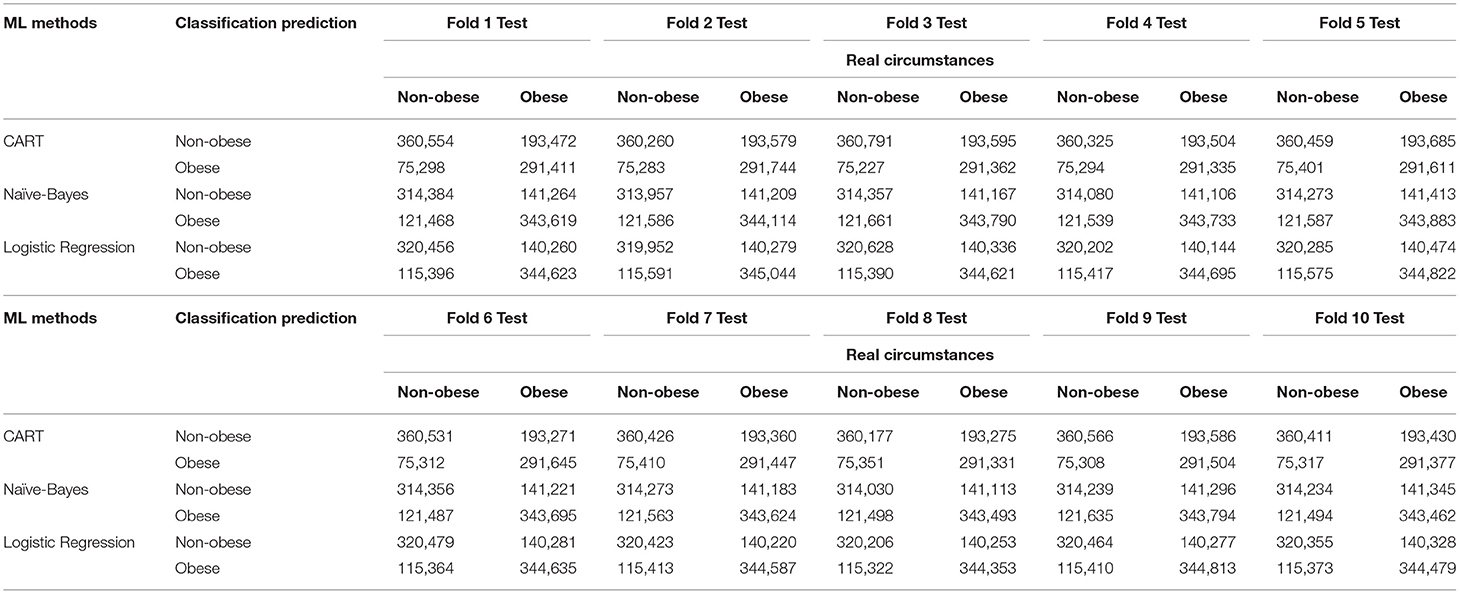
Table 2. Comparison of classification accuracy with 10-fold CV based on the obesity test data using three models with confusion matrix.
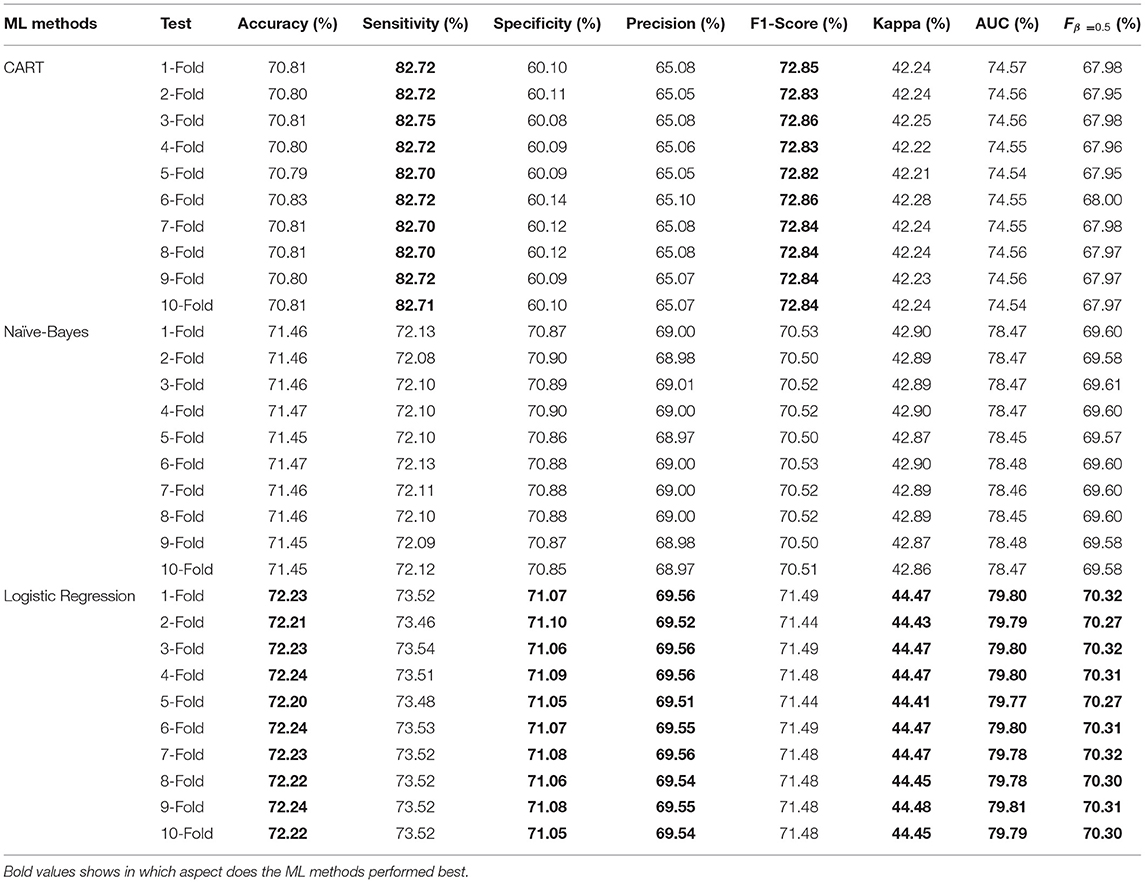
Table 3. Evaluation of classification prediction performance with 10-fold CV based on the obesity test data using 3 ML methods.
The prediction performance for the classification of obesity status from these methods is also assessed based on accuracy, sensitivity, specificity, precision, recall, F1-score, kappa, and Fβ. The measurement results of these metrics based on the 10-fold CV using ML methods for the obesity data set can be seen in Table 3. Based on Table 3, the classification prediction using the Logistic Regression method achieves the best performance based on the accuracy metric (72%), specificity (71%), precision (69%), Kappa (44%), and Fβ (70%). Classification prediction by the CART method achieves the highest sensitivity (82%) and the highest F1-score (72%).
Figures 1–3 show AUC performance of the respective classification methods with 10-fold CV. The results show that the Logistic Regression classifier has the highest average AUC values (0.798) (Figure 3). In addition to comparing the AUC values obtained, the accuracy, sensitivity, specificity, precision, F1-Score, and Fβ values of each method can also be considered. The AUC is a classification threshold invariant metric that measures the predictive quality of a model regardless of which classification threshold is selected.
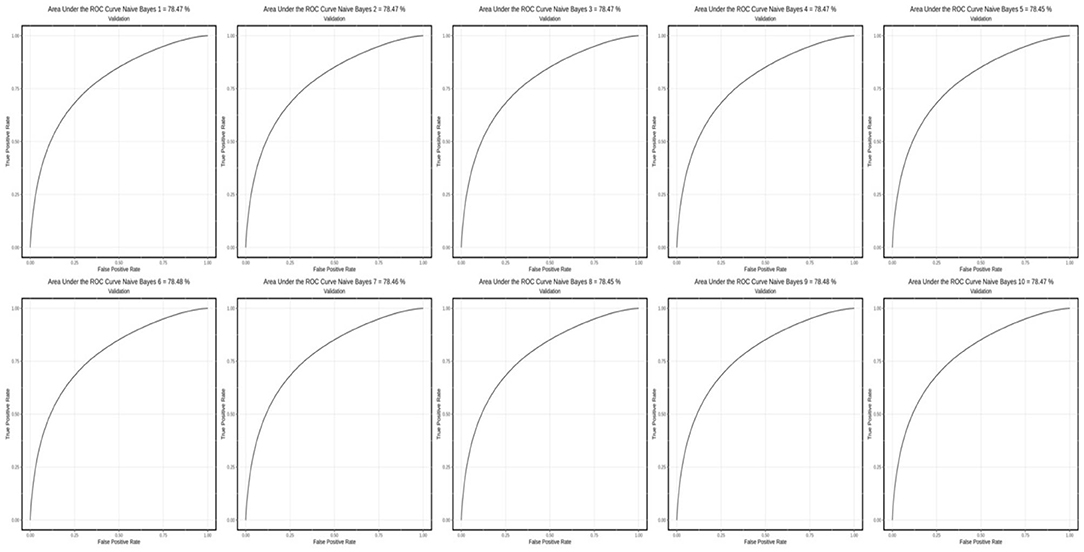
Figure 2. AUC performance on the classification method with the 10-fold CV using the Naïve Bayes method.
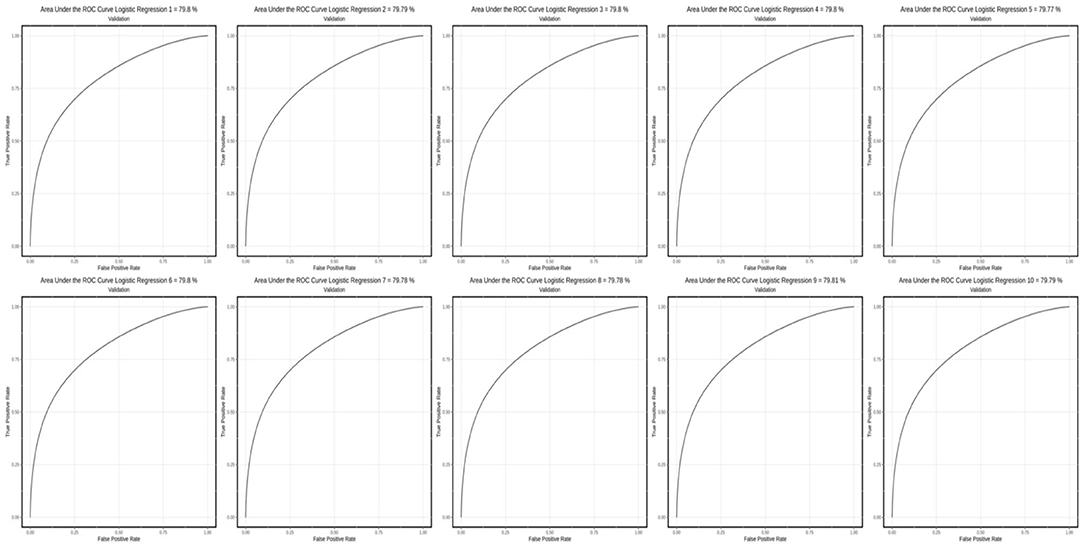
Figure 3. AUC performance on the classification method with the 10-fold CV using the Logistic Regression method.
After calculating the classification performance for correctly determining the obesity status for each of the 3 different models, it is also necessary to estimate a set of risk factors for obesity among the available study variables. Based on the evaluation of classification prediction performance, the Logistic Regression method had the better performance compared with the CART method and the Naïve Bayes method. Overall, fold 6 out of 10-fold CV showed the best accuracy for the classification performance of the obesity status. Partial testing of parameters of the Logistic Regression model using the Wald test showed that all explanatory variables qualify as factors that can affect the obesity status (Table 4). From Table 4, the variables that have the greatest effect on the obesity status in adults (p-value <0.05) included location (X1), marital status (X2), age groups (X3), education (X4), sweet drinks (X7), fatty/oily foods (X9), grilled foods (X10), preserved foods (X11), seasoning powders (X12), soft/carbonated drinks (X13), alcoholic drinks (X16), mental emotional disorders (X17), diagnosed hypertension (X18), physical activity (X19), smoking (X20), and fruit and vegetables consumptions (X21).
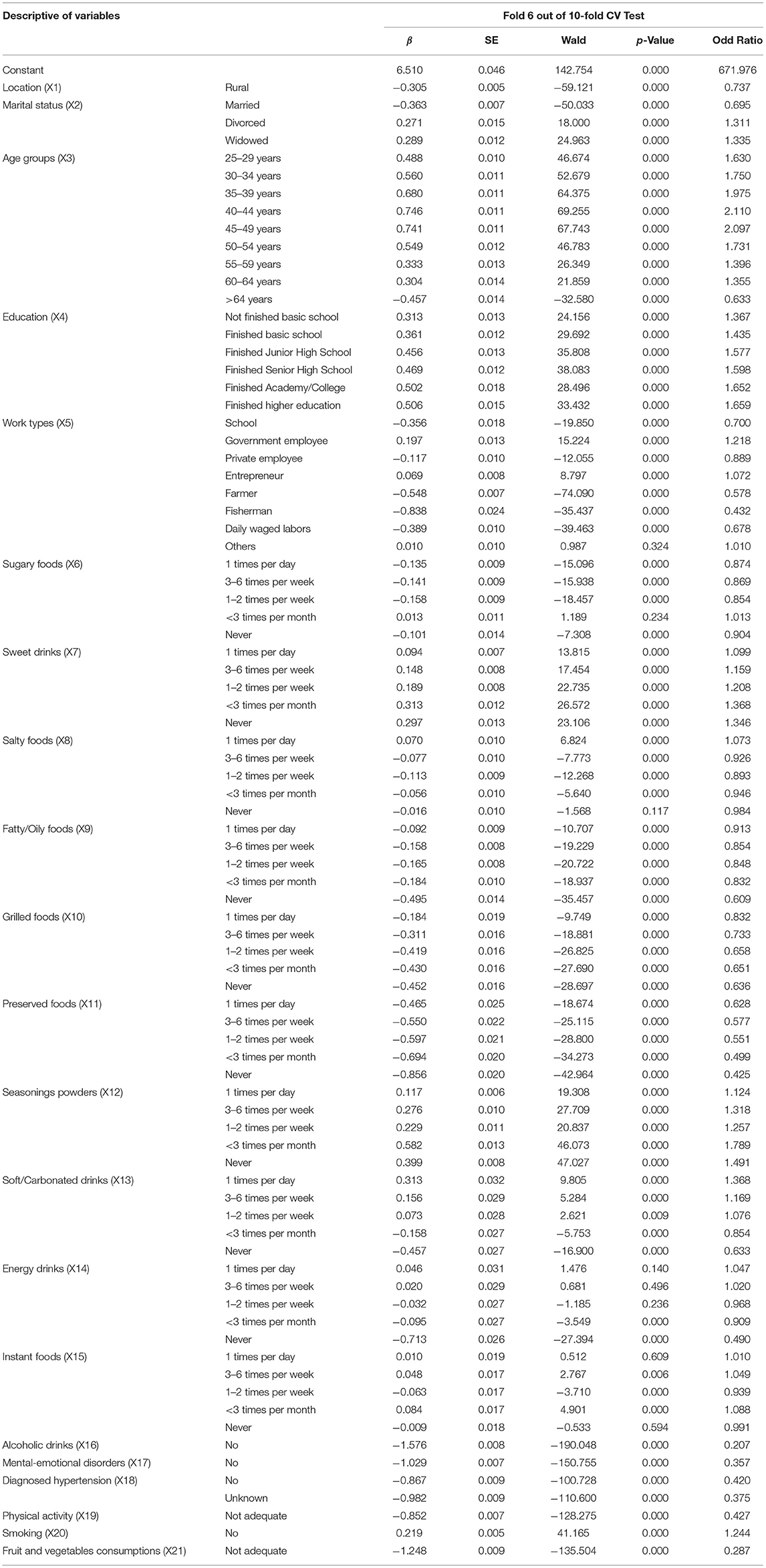
Table 4. Estimation of the Logistic Regression parameters based on fold 6 out of the 10-fold CV for obesity dataset in Indonesian RISKESDAS 2018 survey.
In addition to the Logistic Regression method, prediction of obesity classification also used CART and Naïve Bayes methods. From Figure 4, it can be seen that the characteristics of the variables that influence the occurrence of obesity in the Indonesia RISKESDAS 2018 are significant variables that function as the main partitioning of all the trees produced. In this case, the main partitioning variables for 10% test data with fold 6 out of the 10-fold CV are alcoholic drinks (X16). The order of important variables in this CART model are alcoholic drinks (X16), energy drinks (X14), soft/carbonated drinks (X13), mental-emotional disorders (X17), fruit and vegetables consumptions (X21), diagnosed hypertension (X18), physical activity (X19), and marital status (X2).
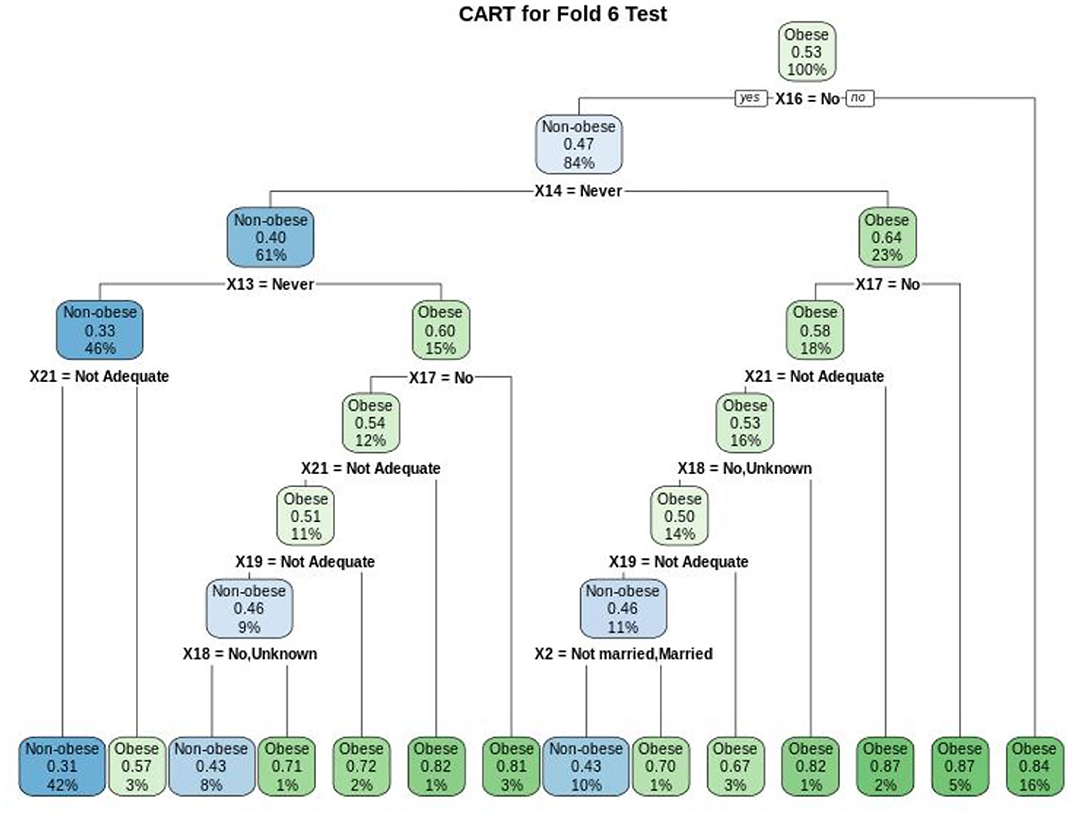
Figure 4. Obesity data classification tree for fold 6 out of the 10-fold CV for CART model based on the variables of alcoholic drinks (X16), energy drinks (X14), soft/carbonated drinks (X13), mental-emotional disorders (X17), Fruit and Vegetables Consumptions (X21), diagnosed hypertension (X18), Physical Activity (X19), and Marital Status (X2).
Obesity prediction using the Naïve Bayes model was also done by looking for values of P(Ci) for the obese class and P(Cj)for the non-obese class. In this case, the value of i = 1 and the value of j = 2. The probability value for each variable on the class label is presented in detail in the Supplementary Table 3.
Discussion
We have conducted a study to establish a set of risk factors for obesity in adults among the available study variables using ML methods using publicly available data on RISKESDAS (RISKESDAS 2018). In this study, three methods (Logistic Regression, CART, and Naïve Bayes) were used in the ML approach to select a method that produces predictions with high accuracy. The result revealed that the Logistic Regression method shows a better accuracy compared to the other methods with AUC = 0.798 using 21 variables, namely location (X1), marital status (X2), age groups (X3), education (X4), work types (X5), sugary foods (X6), sweet drinks (X7), fatty/oily foods (X9), grilled foods (X10), preserved foods (X11), seasoning powders (X12), soft/carbonated drinks (X13), energy drinks (X14), instant foods (X15), alcoholic drinks (X16), mental emotional disorders (X17), diagnosed hypertension (X18), physical activity (X19), smoking (X20), and fruit and vegetables consumptions (X21).
With the accelerated economic growth and lifestyle changes around the world, including in Indonesia, it is important to evaluate and build predictive models for obesity using common risk factors. Based on RISKESDAS 2013 and 2018, Indonesia as a middle-income country seems to underestimate the significance of actual obesity cases even though there has been a significant increase in cases. As shown in this study, the 21 selected measures play a prominent role in increasing the risk for obesity in adults. This is in parallel with some previous studies. In their study, Roemling and Qaim (4) found that obesity risk in Indonesia occurred both in rural and urban areas and was closely associated with food consumption pattern changes coupled with physical activity decreases. Rachmi et al. (5) showed that the increasing prevalence of overweight children, adolescents, and adults in Indonesia over the past two decades coincides with higher numbers of obesity in urban areas. Similarly, Oddo et al. (6) demonstrated that there were more obesity cases in rural areas compared to the past even though the overall case numbers are still higher in urban areas in Indonesia. They also showed that highly processed foods are mostly consumed and decreased physical activities have led to the higher prevalence of obesity. Dewi et al. (7) found that the consumption of oil and fat, animal source foods, and low physical activities are some of the significant determinants of obesity in Indonesia. Emery et al. (40) revealed that there was a relationship between less healthy food consumption with obesity. Sinha and Jastreboff (41) found that eating habits and the increased consumption of food result from stress. Koski and Naukkarinen (42) strengthened the fact that the development of obesity is significantly due to persistent stress. The difference in confounding factors involved in the analysis is one of the reasons for the differences found in this study with previous studies.
In this study, we employed the metrics for accuracy, sensitivity, specificity, precision, recall, F1-score, kappa, and Fβ with 10-fold CV for performance evaluation of the three classification methods. The results obtained are the prediction of the classification with 10-fold CV using the Logistic Regression method, which achieved the best performance as assessed by the accuracy metric (72%), specificity (71%), precision (69%), kappa (44%), and Fβ = 0.5 (70%). Classification prediction by the CART method achieved the highest sensitivity (82%), and F1-score (72%). The Naïve Bayes method had an accuracy of 71% and a Fβ = 0.5 of 69%.
In general, this ML approach is an alternative to the classical methods used so far (22). Using ML methods on public health data can help to improve predictions and find a rich structure among available data and increase understanding of complex problems in public health, including risk factors for obesity with ML. The ML method could inform the design of more appropriate health policies and programs to address Non-Communicable Diseases, most notably in predicting obesity incidence/prevalence, and in turn, reducing severity as well as the cost of treating obesity and obesity-related condition which eventually could improve the health and well-being of the population. Apart from that, the ML method as shown in the current study could be utilized to identify the most significant risk factors for predicting obesity status can be applied to publicly available data, such as RISKESDAS data.
In general, RISKESDAS provides an overview of Indonesian health indicators, such as health status, health services, health behavior, and environmental health. RISKESDAS is supposedly the best data available on health in Indonesia but its main limitation is the fact that the purpose and nature of RISKESDAS are based on a periodic study (every 5 years) examining a broad range of health issues and health behaviors. This then results in a data set that lacks depth.
In Indonesia, policies on obesity prevention and control in adults are related to limiting consumption of fats and oils, sugary foods and carbohydrates, and increasing vegetable intake are carried out through the Health Community Movement, known as GERMAS and the Food Label with the inclusion of sugar, salt, and fat content on food labels (7). Yet, these efforts seem to be ineffective as the increase in the proportion of obesity remains relatively high. The findings of this study in predicting the risk factor for obesity among the available study variables on RISKESDAS 2018 can then convince the policy makers in Indonesia (primarily the government) to put more attention into the pressing obesity problems. As a result, the effectiveness of existing program policies could be further improved and the financing of the health care system can be made more efficient (43).
This study provides an overview of the methods available for predicting risk factors for obesity in adults among the available study variables in Indonesia. Several factors that might influence obesity (e.g., sex, dietary quality, clinical and physiological, wealth, genetic and cultural influences) were not included in this study, and thereby, the relationship between these factors and obesity cannot be explained further. Further research needs to be carried out using large datasets with individual subjects to confirm the results of this study and to describe the variation in the results for individual regions.
Conclusion
The Logistic Regression method showed better results on the accuracy, specificity, precision, kappa, and Fβ metrics. Meanwhile, the CART method showed better results on the sensitivity, recall, and F1-score. For the 10-fold CV, the Logistic Regression method had the highest AUC performance which was 0.798. Then, from the Logistic Regression method, it can also be seen that the variables that affect the prediction of obesity status in adults are location, marital status, age groups, education, sweet drinks, fatty/oily foods, grilled foods, preserved foods, seasoning powders, soft/carbonated drinks, alcoholic drinks, mental emotional disorders, diagnosed hypertension, physical activity, smoking, and fruit and vegetables consumptions. The constructed obesity classification model can evaluate and predict the risk of obesity using ML methods for the population of Indonesia which can then be applied to publicly available open data, such as the RISKESDAS survey data. In general, this study has been able to establish a set of risk factors for obesity in adults among the available study variables. However, more studies should be done to further improve the quality of predictions by exploring other ML models. In the future work, we will validate the results with other relevant groups. Additionally, we will also evaluate differences in the prediction of obesity status at the district/city or province level in Indonesia with regional disaggregation.
Data Availability Statement
Publicly available datasets were analyzed in this study. This data can be found at: https://www.litbang.kemkes.go.id/layanan-permintaan-data-riset.
Author Contributions
ST contributed to the concept and design of the study, carried out the statistical analysis, and wrote the manuscript. DA interpreted the data, analyzed, and wrote the manuscript. HK collected the necessary data and carried out the statistical analysis. AL interpreted the data and analyzed the manuscript. SN analyzed and wrote the manuscript. All authors read and approved the final manuscript.
Funding
This research was funded by the Ministry of Research, Technology/National Research, and Innovation Agency of Indonesia through Grant PDUPT Hasanuddin University in 2020 with the number 1516/UN4.22/PT.01.03/2020.
Conflict of Interest
The authors declare that the research was conducted in the absence of any commercial or financial relationships that could be construed as a potential conflict of interest.
Acknowledgments
ST would like to thank the Ministry of Research and Technology/National Research and Innovation Agency for funding this research through the PDUPT Scheme for the 2020 fiscal year. In addition, the authors would also like to thank the Ministry of Health through the Community Research and Development Agency for providing access to the Indonesian RISKESDAS survey data.
Supplementary Material
The Supplementary Material for this article can be found online at: https://www.frontiersin.org/articles/10.3389/fnut.2021.669155/full#supplementary-material
References
1. ASEAN/UNICEF/WHO Regional Report. World Health Statistics 2016: Monitoring Health for the SDGs, Sustainable Development Goals. (2016). Available online at: https://www.who.int/about/licensing/copyright_form/en/index.html
2. Institute of Health Research and Development. Basic Health Research Reports. (2013). Available online at: https://www.litbang.kemkes.go.id/laporan-riset-kesehatan-dasar-riskesdas/
3. Institute of Health Research and Development. Basic Health Research Reports. (2018). Available online at: http://labdata.litbang.kemkes.go.id/images/download/laporan/RKD/2013/Laporan_riskesdas_2013_final.pdf
4. Roemling C, Qaim M. Obesity trends and determinants in Indonesia. Appetite. (2012) 58:1005–13. doi: 10.1016/j.appet.2012.02.053
5. Rachmi CN, Li M, Alison Baur L. Overweight and obesity in Indonesia: prevalence and risk factors-a literature review. Public Health. (2017) 147:20–9. doi: 10.1016/j.puhe.2017.02.002
6. Oddo VM, Maehara M, Rah JH. Overweight in Indonesia: an observational study of trends and risk factors among adults and children. BMJ Open. (2019) 9:e031198. doi: 10.1136/bmjopen-2019-031198
7. Dewi NU, Tanziha I, Solechah SA, Bohari B. Obesity determinants and the policy implications for the prevention and management of obesity in Indonesia. Curr Res Nutr Food Sci J. (2020) 8:942–55. doi: 10.12944/CRNFS.8.3.22
8. Wiemken TL, Kelley RR. Machine learning in epidemiology and health outcomes research. Annu Rev Public Health. (2020) 41:21–36. doi: 10.1146/annurev-publhealth-040119-094437
9. Giabbanelli PJ, Adams J. Identifying small groups of foods that can predict achievement of key dietary recommendations: data mining of the UK National Diet and Nutrition Survey, 2008–12. Public Health Nutr. (2016) 19:1543–51. doi: 10.1017/S1368980016000185
10. Dugan TM, Mukhopadhyay S, Carroll A, Downs S. Machine learning techniques for prediction of early childhood obesity. Appl Clin Inform. (2015) 6:506–20. doi: 10.4338/ACI-2015-03-RA-0036
11. Nau C, Ellis H, Huang H, Schwartz BS, Hirsch A, Bailey-Davis L, et al. Exploring the forest instead of the trees: an innovative method for defining obesogenic and obesoprotective environments. Health Place. (2015) 35:136–46. doi: 10.1016/j.healthplace.2015.08.002
12. Acharjee A, Ament Z, West JA, Stanley E, Griffin JL. Integration of metabolomics, lipidomics and clinical data using a machine learning method. BMC Bioinformatics. (2016) 17:440. doi: 10.1186/s12859-016-1292-2
13. Selya AS, Anshutz D. Machine learning for the classification of obesity from dietary and physical activity patterns. In: Giabbanelli P, Mago V, Papageorgiou E, editors. Advanced Data Analytics in Health. Springer (2018). p. 77–97. Available online at: http://doi-org-443.webvpn.fjmu.edu.cn/10.1007/978-3-319-77911-9_5
14. Zhang S, Tjortjis C, Zeng X, Qiao H, Buchan I, Keane J. Comparing data mining methods with logistic regression in childhood obesity prediction. Inform Syst Front. (2009) 11:449–60. doi: 10.1007/s10796-009-9157-0
15. Adnan MHBM, Husain W, Rashid NA. Parameter identification and selection for childhood obesity prediction using data mining. In: 2nd International Conference on Management and Artificial Intelligence. Singapore (2012). p. 7.
16. Toschke AM, Beyerlein A, Von Kries R. Children at high risk for overweight: a classification and regression trees analysis approach. Obes Res. (2005) 13:1270–4. doi: 10.1038/oby.2005.151
17. Golino HF, Amaral LSB, Duarte SFP, Gomes CMA, Soares J, Reis LA, et al. Predicting increased blood pressure using machine learning. J Obes. (2014) 2014:637635. doi: 10.1155/2014/637635
18. Zheng Z, Ruggiero K. Using machine learning to predict obesity in high school students. In: 2017 IEEE International Conference on Bioinformatics and Biomedicine (BIBM). Kansas (2017). p. 2132–2138. doi: 10.1109/BIBM.2017.8217988
19. Chatterjee A, Gerdes MW, Martinez SG. Identification of risk factors associated with obesity and overweight–a machine learning overview. Sensors. (2020) 20:2734. doi: 10.3390/s20092734
20. Singh B, Tawfik H. Machine learning approach for the early prediction of the risk of overweight and obesity in young people. Comput Sci ICCS 2020. (2020). 12140:523–35. doi: 10.1007/978-3-030-50423-6_39
21. Colmenarejo G. Machine learning models to predict childhood and adolescent obesity: a review. Nutrients. (2020) 12:2466. doi: 10.3390/nu12082466
22. DeGregory KW, Kuiper P, DeSilvio T, Pleuss JD, Miller R, Roginski JW, et al. A review of machine learning in obesity. Obes Rev. (2018) 19:668–85. doi: 10.1111/obr.12667
23. Wickham H, François R, Henry L, Müller K. dplyr: A Grammar of Data Manipulation. R package version 0.7.6 (2018). Available online at: https://cran.r-project.org/package=dplyr
24. Blum AL, Langley P. Selection of relevant features and examples in machine learning. Artif Intell. (1997) 97:245–71. doi: 10.1016/S0004-3702(97)00063-5
25. R Core Team. R: A Language and Environment for Statistical Computing. Vienna: R Foundation for Statistical Computing (2020).
26. Chawla NV, Bowyer KW, Hall LO, Kegelmeyer WP. SMOTE: synthetic minority over-sampling technique. J Artif Intell Res. (2002) 16:321–57. doi: 10.1613/jair.953
27. Chawla NV. Data mining for imbalanced datasets: an overview. In: Maimon O, Rokach L, editors. Data Mining and Knowledge Discovery Handbook. Boston, MA: Springer (2005). p. 853–67. doi: 10.1007/0-387-25465-X_40
28. Blagus R, Lusa L. Joint use of over- and under-sampling techniques and cross-validation for the development and assessment of prediction models. BMC Bioinformatics. (2015) 16:363. doi: 10.1186/s12859-015-0784-9
29. Alghamdi M, Al-Mallah M, Keteyian S, Brawner C, Ehrman J, Sakr S. Predicting diabetes mellitus using SMOTE and ensemble machine learning approach: the Henry Ford ExercIse Testing (FIT) project. PLoS ONE. (2017) 12:e0179805. doi: 10.1371/journal.pone.0179805
30. Cost S, Salzberg S. A weighted nearest neighbor algorithm for learning with symbolic features. Mach Learn. (1993) 10:57–78. doi: 10.1023/A:1022664626993
31. Hastie T, Tibshirani R, Friedman J. The Elements of Statistical Learning: Data Mining, Inference, and Prediction. Springer-Verlag (2009). Available online at: https://web.stanford.edu/~hastie/ElemStatLearn/
32. Bishop C. Pattern Recognition and Machine Learning. Springer-Verlag New York (2006). Available online at: https://www.springer.com/gp/book/9780387310732
33. Breiman L, Friedman JH, Olshen RA, Stone CJ. Classification and Regression Trees. Washington, DC: Chapman & Hall; CRC (1984).
34. Han J, Kamber M, Pei J. Data mining: Concepts and Techniques, 3rd ed. Morgan Kaufmann Publishers (2012). Available online at: http://myweb.sabanciuniv.edu/rdehkharghani/files/2016/02/The-Morgan-Kaufmann-Series-in-Data-Management-Systems-Jiawei-Han-Micheline-Kamber-Jian-Pei-Data-Mining.-Concepts-and-Techniques-3rd-Edition-Morgan-Kaufmann-2011.pdf
35. Refaeilzadeh P, Tang L, Liu H. Cross-validation. In: LIU L, ÖZSU MT, editors. Encyclopedia of Database Systems. Boston, MA: Springer (2009). p. 24. doi: 10.1007/978-0-387-39940-9
36. Liu B, Fang L, Liu F, Wang X, Chen J, Chou KC. Identification of real microRNA precursors with a pseudo structure status composition approach. PLoS ONE. (2015) 10:e0121501. doi: 10.1371/journal.pone.0121501
37. Nguyen GH, Bouzerdoum A, Phung SL. Learning Pattern Classification Tasks with Imbalanced Data Sets. London: IntechOpen (2009). doi: 10.5772/7544
38. Landis J, Koch G. The measurement of observer agreement for categorical data. Biometrics. (1977) 33:159–74. doi: 10.2307/2529310
39. Brefeld U, Scheffer T. AUC maximizing support vector learning. In: Ferri C, Lachiche N, Macskassy S, Rakotomamonjy A, editors. Proceedings of the 2nd Workshop on ROC Analysis in Machine Learning (ROCML 2005). (2005). Available online at: https://citeseerx.ist.psu.edu/viewdoc/download?doi=10.1.1.59.7864&rep=rep1&type=pdf
40. Emery CF, Olson KL, Lee VS, Habash DL, Nasar JL, Bodine A. Home environment and psychosocial predictors of obesity status among community-residing men and women. Int J Obes. (2015) 39:1401–7. doi: 10.1038/ijo.2015.70
41. Sinha R, Jastreboff AM. Stress as a common risk factor for obesity and addiction. Biol Psychiatry. (2013) 73:827–35. doi: 10.1016/j.biopsych.2013.01.032
42. Koski M, Naukkarinen H. The relationship between stress and severe obesity: a case-control study. Biomed Hub. (2017) 2:1–13. doi: 10.1159/000458771
Keywords: classification, Logistic Regression, machine learning, Naive Bayes, obesity status
Citation: Thamrin SA, Arsyad DS, Kuswanto H, Lawi A and Nasir S (2021) Predicting Obesity in Adults Using Machine Learning Techniques: An Analysis of Indonesian Basic Health Research 2018. Front. Nutr. 8:669155. doi: 10.3389/fnut.2021.669155
Received: 18 February 2021; Accepted: 27 April 2021;
Published: 21 June 2021.
Edited by:
Francesco Sofi, Università degli Studi di Firenze, ItalyReviewed by:
José María Huerta, Instituto de Salud Carlos III (ISCIII), SpainRosa Casas Rodriguez, Institut de Recerca Biomèdica August Pi i Sunyer (IDIBAPS), Spain
Copyright © 2021 Thamrin, Arsyad, Kuswanto, Lawi and Nasir. This is an open-access article distributed under the terms of the Creative Commons Attribution License (CC BY). The use, distribution or reproduction in other forums is permitted, provided the original author(s) and the copyright owner(s) are credited and that the original publication in this journal is cited, in accordance with accepted academic practice. No use, distribution or reproduction is permitted which does not comply with these terms.
*Correspondence: Sri Astuti Thamrin, dHV0aUB1bmhhcy5hYy5pZA==
†These authors have contributed equally to this work and share first authorship
 Sri Astuti Thamrin
Sri Astuti Thamrin Dian Sidik Arsyad
Dian Sidik Arsyad Hedi Kuswanto
Hedi Kuswanto Armin Lawi
Armin Lawi Sudirman Nasir
Sudirman Nasir
